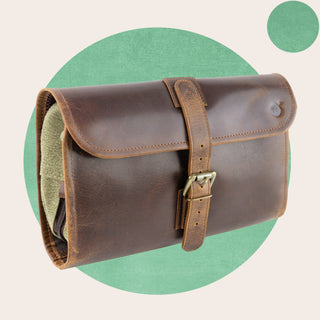Has this ever happened to you? When you leave your house, the sun is shining. So, you grab your favorite leather jacket, leather shoes, or leather handbag. While you’re out, the weather changes, and suddenly it's raining! Your favorite leather goods are damp, or even soaked! If you’re dealing with a similar wet leather situation, the first question on your mind is probably, “can leather get wet?” There isn’t a cut and dry (pun intended) answer to this question, so let’s take a closer look in the sections below.
Can leather get wet?
So, can leather shoes get wet? Can a leather jacket get wet? While leather can technically get wet, it certainly is less than ideal to get leather wet. There are natural oils in leather, just as you’ll find in your own skin. If the leather gets wet, these oils bind themselves to the water molecules. That means when the water evaporates from the leather, many of the natural oils will also leave the material as well. When this happens, your leather will feel dry and brittle, nothing like the smooth and supple feel it should have.
Does water ruin leather?
Can you get leather wet? If leather gets wet, it doesn’t always mean that it is ruined for good. However, there is an increased chance of damage to your leather goods if they get wet. First, as described above, after leather dries, many of the natural oils will also disappear. This will leave the leather dry and stiff.
After the leather gets wet, you may also be left with some water stains on your favorite leather item. While you may be able to remove or minimize the appearance of these stains (as we’ll get into below), doing so isn’t always possible. This darkening effect of water can certainly impact the overall appearance of your leather.
In some cases, if leather gets too wet and isn’t able to dry out quickly enough, the material could rot. This, clearly, would be the worst case scenario and why you’ll want to work to keep your leather dry and act quickly if it does get wet.
How to Dry Wet Leather
The steps to dry a wet leather jacket, leather shoes, or leather messenger bag will vary based on the type of leather that the item is made from. Read the directions below to learn how to best handle different wet leathers.
Regardless of the type of leather you are drying, avoid using unnatural heat to dry it. Always allow leather to dry naturally (after following the additional steps outlined below). Using a blow dryer could cause the material to shrink or warp.

Smooth Leather
Smooth, vegetable tanned leather is typically full-grain leather. Because this type of leather is made using the outermost layer of the animal’s hide, it is more likely to absorb water and stain than some other types of leather.
Before you try to dry smooth leather, start by washing your hands. Our skin has lots of natural oils, and the leather may absorb these oils, which could discolor it. Then, use a soft, dry cloth to carefully and gently dab off any excess water from the leather. Don’t wipe, just gently dab.
After dabbing off the excess water, leave the leather to air dry. To dry wet leather duffle bags or briefcases, stuff them with newspaper or tissue paper to prevent the item from getting misshapen.
After the leather has fully dried, follow up with a thick coat of a good quality leather conditioner to help moisturize the material and keep it from getting stiff. The following day, buff the surface.

Grained Leather
Most grained or patterned leather goods are chrome tanned and have a layer of paint that can make them a bit more water resistant than vegetable tanned leather.
To dry your top grain or full grain leather items, blot the entire surface that is wet with a dry cloth. Similarly to smooth leather, you will want to leave the item to air dry overnight or until it is completely dry.
Once dry, use a reasonably thick coat of Carl Friedrik’s Leather Cream or another high quality leather conditioner to moisturize the item and return some of the natural oils that were lost.
Suede
Drying suede is similar to drying grained and smooth leathers. Start with a lint-free cloth to gently wipe away any excess moisture. Then, using a medium-bristle toothbrush or soft-bristle brush, brush the suede for a few minutes to help restore its finish. You can briefly use a blow dryer during this step to help bring back the suede’s nap. Then, leave the suede to dry completely.
How to Get a Water Stain out of Leather
If you are dealing with water damaged item (whether it's a wallet, a jacket, or a leather portfolio) and want to know how to get water stain out of leather, choose a top-quality commercial leather cleaner. Test the cleaner on an inconspicuous area to ensure it won’t leave new stains on the leather. Then, use a soft cloth to gently wipe the leather cleaner over the water stain. After the area has fully dried, apply leather conditioner.

Protecting Leather Against Water
Is leather waterproof? No, leather is not a naturally waterproof or water resistant material. However, there are different protective coatings you can apply to help protect your leather goods. Waterproofing spray and beeswax cream are two different options to consider for preventing leather from being damaged from water. However, keep in mind that even with a water and stain repellent, your leather can still be damaged. You will still want to take excellent care of your items and try to prevent them from getting wet when possible.

Final Thoughts: Can Leather Get Wet?
Doing what you can to keep leather dry is important. However, if your leather does get wet, it isn’t necessarily cause to panic. Following the suggestions shared above to help your leather dry out quickly or taking measures to make it water and stain resistant can help your favorite leather pieces continue to look their best for years to come.
FAQs
How do you fix leather after it gets wet?
If leather gets wet, use a dry cloth to gently soak up as much excess water as possible. Then, leave the leather in a dry area with plenty of airflow to let it air dry. Do not try to rush the process or apply unnatural heat, such as that from a blow dryer.
Can leather survive water?
Yes, leather can survive water. However, you will want to work quickly to carefully dry it and apply a leather conditioner to keep it from getting brittle or stiff.
Can you leave leather in the rain?
No, you should never leave leather in a rain shower.



